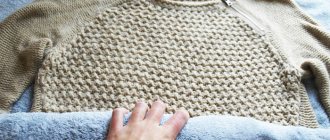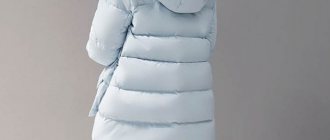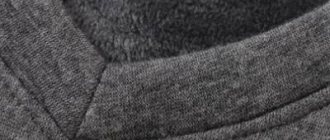Practical and beautiful artificial fabric is loved by many and is present in almost every wardrobe. The fabric is delicate and causes difficulties for housewives who do not know how to wash viscose. Things deteriorate and become deformed due to the fragility of wet fiber. The capriciousness is explained by the presence of a natural cellulose base.
Clothing and home textiles made of viscose will retain their shape and attractiveness longer if you follow washing and care rules that take into account the characteristics of the material.
Possible consequences of improper washing
- Violation of the temperature regime leads to the fact that viscose shrinks after washing. This most often happens with items that contain wool or acrylic fibers.
- Proper drying of viscose is no less important for maintaining the original condition of clothing. When you don’t have time to dry your favorite dress and have to wear it wet, there is a high probability that the product will stretch, increasing in volume by a couple of sizes.
- Viscose with the addition of polyester thread is prone to the formation of pills, spoiling the appearance of clothes. One of the reasons for their appearance is washing in a machine drum. Therefore, you need to use a laundry bag.
- For viscose items, do not use steamers or hang them on a line to dry. The material stretches from its own weight and cannot be restored.
The ugly truth about wrinkled fabrics | crafts fair magazine
There are questions that clients ask more often than others. One of these questions: “Does the fabric wrinkle a lot?” I will try to answer in detail and with clear examples. I think this information will help you when shopping online, when you cannot touch the product and evaluate it in person.
Buyers at the Crafts Fair love natural fabrics; for many, this is almost the most important criterion when choosing clothes. But I want these natural fabrics not to wrinkle. It happens? The short answer is “no”. But everything is relative, let's look at the nuances.
We suggest you read How to save tools from rust | Magazine of the Fair of Masters
The general rule for natural fabrics is that they wrinkle. Compared to synthetic fabrics, they wrinkle very much. If you want your skirt to look like it has been freshly ironed after a day of sitting in the office, look among synthetics.
But if we take synthetic materials out of the equation, the following remains.
I’ll make a reservation that this is not a retelling of a textbook on materials science, a chapter about the properties of fabrics. These are the conclusions that I made from my own experience; over more than 5 years of work, a lot of fabrics have passed through my hands. I think that in 90% of cases these rules will work, but, of course, there are exceptions.
- The first thing you should pay attention to is the composition of the fabric.
In my experience, linen wrinkles the most. So much so that designers prefer to use it more as an advantage in relaxed boho style products. Then, in descending order, there are viscose, cotton and wool fabrics. From top to bottom: linen, cotton, viscose and wool. I wrote above that viscose wrinkles more than cotton, but for example I took something that doesn’t wrinkle much. I’m sitting here wondering if this is really the sequence. They probably wrinkle about the same, it’s just that I’ve encountered viscose that wrinkles a lot more often, and cotton has been much more resistant to wrinkles. But this is probably due to the properties that I will list below. - Fabric color and pattern.
We are not talking about physical properties, but about optical illusions. How noticeable the bruise is depends on the color and pattern. You've probably noticed that a colorful dress doesn't wrinkle as much as a plain one. The more detailed and colorful the pattern on the fabric, the less wrinkled it seems. On plain materials everything is visible at a glance. Regarding color: dark fabrics usually look neater than light ones. But on bright colors, bruising can be most noticeable. Solid red linen, melange blue and variegated blue-gray. If you don’t want to look wrinkled, you should opt for a more variegated fabric made by weaving threads of different colors. Printed designs also hide wrinkles well, but the thread pattern, in my opinion, is much better. - Texture.
If the fabric is made by interlacing threads of different thicknesses or colors, it wrinkles much less than smooth, non-textured fabric. This is somewhat similar to the next point about loose fabrics, but is not always the same thing. The textured threads of the material on the left will delight, and the smooth, textureless wool on the right will make lovers of ironed clothes nervous. It will only look smooth on a hanger or on a catwalk model. - Thickness and density are important properties of fabric.
Woven fabric can be thin or thick, dense or loose: it depends on the threads and weave. If the threads are intertwined loosely, the fabric is loose. Thin and dense fabrics wrinkle more noticeably than thick and loose fabrics. For example, thick and loose cotton muslin is not as fussy as thin and stiff cotton poplin. This also works with wool fabrics. Thin, dense woolen fabrics wrinkle a lot. Thick, loose - weak. However, there is fabric that is thin and loose. The looseness of the fabric compensates for its thinness, and the material may not wrinkle much. From bottom to top: the most wrinkled thin dress gray wool, thicker blue suit wool and very thick gray coat material. For woolen fabrics, fabric impregnation is also important. Sometimes in the store the fabric seems not to wrinkle at all, but after the first wash it begins to wrinkle a lot. This is why it is often recommended to dry-clean wool rather than wash it in a machine at home. Not because something terrible will happen to it, it just may lose its good consumer properties that it had thanks to impregnation.
Recently, a way to outwit this system has emerged: they make fabrics with a built-in “wrinkled effect.” For example, cotton with a textured surface, which initially looks wrinkled, but evenly. Overall, the product looks neat. However, such fabrics are unlikely to fit into an emphatically elegant classic style.
Everything would be fine if not for the cheerful combinatorics of these properties, neutralizing or enhancing each other. It happens that the looseness of the material helps it not to wrinkle, despite its thinness and uniform color. And vice versa, there are thick coat wools that are so scary that you are scared to get into the car, because the cloth is so smooth and hard that every wrinkle is noticeable on it. But you can roughly navigate and predict whether this or that material will wrinkle. If everything about the color is more or less clear from the photographs, other properties can be clarified with the seller. Of course, you can simply ask the question: “Does it wrinkle a lot?”, but it’s always better to be armed with a theoretical basis, right? So, if the issue of wrinkles does not bother you at all, you can safely sew blouses from plain cotton cambric. If you need the same blouse for the hot weather, but more practical, you can opt for viscose with a floral print. For a special occasion, you can buy a dress made of thin, plain wool, but for everyday wear, something pockmarked, melange, checkered, denser and looser is better. But in any case, is it better to suffer with the selection of fabric or with an iron than to wear practical synthetics?
We invite you to familiarize yourself with Down jacket made from camel hair: how to wash and remove stains
I also wanted to know what topics interest you? I plan to write general instructions for caring for fabrics (yes, it can be made general and universal), write separately about ironing things (an iron can do wonders for your appearance, and I’ll also tell you what to do if you don’t want to iron at all). Something else? What information will be useful to you for easier and more confident distance shopping for clothes?
How to prepare things for washing
- Start by studying the label, which indicates the temperature and washing method. For different products, care requirements may vary depending on the composition and type of fibers.
- Wash items strictly by type: light, black and colored.
- When machine washing, use a mesh bag in which the material will not rub against the walls of the drum. It will protect the fabric from snagging and pilling.
- Hooks, zippers and buttons on clothing should be fastened to avoid damaging delicate fibers.
- Wash all viscose items inside out.
- If heavily soiled, clothes should be pre-soaked. Dilute the powder or liquid preparation in a bowl of warm water (30-35°). Place the clothes there for 30-40 minutes. After this, squeeze lightly and start washing.
Washing Tips
- Viscose fabrics are sensitive to direct contact with chemicals and homemade stain removers such as vinegar, ammonia, and baking soda.
- Viscose knitwear is recommended to be washed in soft water. A few drops of ammonia, which is thoroughly mixed beforehand, will help soften it additionally.
- Water with the addition of a spoonful of vinegar can refresh the color and make the fabric smoother.
- White viscose items do not fade, but are prone to staining from sunlight. This is another argument not to dry clothes in the sun. If stains have already appeared, hydrogen peroxide or oxygen bleach containing sodium hypochlorite will help remove them.
- There is no need to remove stains on viscose fabric with soap and vigorous rubbing. This deteriorates the fiber structure.
- Choose detergents that do not contain alkali or chlorine, which destroy viscose.
Wrinkle or not
I spent the next part of the study in the fabric department, checking the creaseability of individual samples. To do this, I squeezed the edge of the material tightly in my palm, counted to 10, then evaluated the effect. On some fabrics, creases disappeared right before our eyes, while others formed deep folds.
Does natural silk wrinkle? Yes, this is one of the most wrinkle-resistant fabrics
- Natural silk and linen turned out to be the clear leaders in the company of highly wrinkled fabrics.
- The multifunctional and inexpensive viscose material - staple - wrinkles well and noticeably.
- Thin cotton fabrics popular in hot weather (gauze, cambric, chiffon, muslin) also formed strong, numerous creases.
- Satin, chiffon and Indian fabric - bengalin - were in no way inferior to competitors in the formation of folds and creases. But their edges are not as sharp as those of cotton fabrics.
- At the next stand, my attention was drawn to a fabric with the strange name lyocell. It turned out that this mixed viscose fabric has all the properties of natural materials. Surprisingly, when I opened my fist, I saw that all the folds were slowly straightened out, the surface remained smooth.
- Also, polyester-based fabrics turned out to be practically wrinkle-resistant. Knitted fabric, elastane, stretch polyester.
Subtleties of hand washing
Washing viscose by hand is not difficult at all if you follow the recommendations.
You should start with soaking. Prepare water t=30-35° with washing or suitable detergent. Hot water negatively affects the structure of the fabric and it shrinks. Immerse the items in the soapy solution, then gently wrinkle and iron the fabric. Avoid rough impact, do not rub, twist or squeeze into a ball. Wet viscose fibers are very fragile and vulnerable. They are highly prone to deformation. Shaking will help remove excess water.
Manufacturing process
The production of artificial fabrics began at the end of the 19th century.
And it has remained virtually unchanged to this day. The raw materials are crushed, boiled in alkali, bleached and pressed. Next, the resulting substance is transported to factories to form the final product. The thread production process includes four stages:
- Obtaining a spinning solution.
- Pressing the substance through a special plate (spinneret) into an acid bath - this is how threads are formed.
- Next comes the finishing stage.
- The drying stage is the final one.
How to machine wash
You shouldn’t deny yourself the pleasure of wearing viscose clothes if you don’t have the opportunity or desire to wash them by hand. A washing machine will successfully cope with this task; you just need to be properly prepared and know how to wash viscose in a washing machine.
- Items should be washed in the drum separately from items made from coarser fabrics.
- Load the clothes into the drum, placing them in the wash bag.
- Turn on the “Manual” or “Delicate” mode on the panel, set the temperature to 30°.
- Automatic spinning in a drum for viscose is contraindicated, so it must be turned off.
- Place liquid detergent or a capsule for washing delicate fabrics in the special compartment. They protect the fibers and reduce friction against the drum walls.
- If there is local contamination, you should add an oxygen stain remover, and for light-colored fabrics, chlorine-free bleach.
- When rinsing, it is recommended to use fabric softener.
Why does viscose deform and how to correct the situation?
Viscose fabrics mixed with other fibers are most susceptible to deformation. Shrinkage is more often observed in low quality products. Natural viscose is durable and serves as a strengthening additive for wool, acrylic, and polyester.
Mistakes that spoil viscose products:
- High temperature exposure and sudden change.
- The use of powders with alkali and aggressive components.
- High-speed spin in a washing machine.
- Strong friction of contaminated areas and twisting.
- Drying near heat sources.
What to do when shrinking
If you wash viscose so that it does not shrink and the size of the item noticeably decreases after washing, then you can try to correct the situation. You should start by simply pulling out the damp item, spread out on the surface. in case of shortening, wet the shirt or dress and hang it on hangers. While suspended, try to stretch it lengthwise.
If this is not enough, then wet the clothes and let the water drain. Put on damp and wear until completely dry. Hot steam while simultaneously pulling with your hands will help to stretch the product.
If the clothes are stretched
When mixing viscose fibers with wool and cotton, the products, on the contrary, stretch after washing. The following techniques will help you reduce the size, which should be chosen taking into account the exact composition of the fabric.
- Combination of viscose and cotton
Cotton is not susceptible to warping, but sometimes it still happens. Washing in hotter water than indicated on the tag, with a spin cycle at medium speed, will help restore the shape. At the end, the products are immersed in hot water with air conditioning for 10 minutes. Dry using a dryer, or spread out on a warm surface.
- With synthetic additives
Clothes are washed with high water heat and spun at maximum speed. Then they are immersed in ice water for a couple of hours. At the end of soaking, carefully squeeze and dry.
- With an admixture of wool fibers
Wool threads are highly susceptible to stretching. To reduce an item by a couple of sizes, wash it at t=+50-60°. The spin is set to the pointer position above 500 rpm. After removing from the machine, wash with cold water and dry flat on a warm, horizontal surface.
What to do if viscose shrinks or stretches after washing
After washing, viscose may lose its shape for the following reasons:
- the automatic mode is incorrectly selected (too high temperature, intense spin);
- the fiber was exposed to strong temperature changes (washed in warm water, rinsed in ice water);
- hand washing errors (friction, twisting);
- drying next to heating devices or radiators.
Alas, in most cases, a stretched viscose item cannot be saved, since the fiber quickly takes on a new shape and cannot “shrink” back. The only option, which gives no guarantees, is to immediately soak the clothes in very cold water for 15 minutes, and then lay them out (do not hang them!) to dry.
If the viscose shrinks after washing, carefully iron the clothing at the minimum permissible temperature, carefully stretching the fabric in the desired direction.
HOW TO EASILY WASH AND DRY KNITTING || LIFE HACK
Watch this video on YouTube
Author of the article: Nina Mitchenko, a housewife with more than 10 years of experience, sees her mission on the site in the transfer of experience
Your mark:
Rules for drying viscose clothes
- Place washed items on wooden or plastic hangers to drain. You shouldn't take metal ones - they leave traces.
- You can lay out and smooth the product on a plane, so it will definitely not be deformed.
- A towel or folded sheet will help remove excess moisture. The blouse is placed on a towel and rolled up, pressing lightly. This way, deformation will be avoided.
- Heated dryers and washer dryers cannot be used. As well as drying wet things on radiators or the active sun. Exposure of viscose to high temperatures causes deformation and shrinkage.
- To dry, items with a high content of viscose fiber should be smoothed by hand on a flat surface.
How to iron viscose fabric
Iron any item of clothing or home textiles made from natural cellulose according to the following recommendations.
- The operation should be carried out exclusively from the wrong side.
- Turn the iron on low heat.
- Iron elements and decor on the front side through gauze.
- Do not use a steamer or topical humidification from a spray bottle. Hot steam causes clothes to stretch.
- If moisturizing is necessary, use damp gauze and iron through it.











